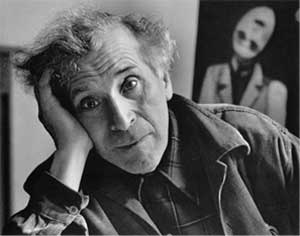Marc Chagall (Marc Chagall)

Artist. Born in Vitebsk, Belarus (in the Russian Empire), and was raised in a devoutly Jewish environment with eight other siblings. His father worked in a fish warehouse, and his mother ran a shop where she sold fish and sundry baking supplies. As a child, Marc attended heder (Jewish elementary school) and later went to public school, where lessons were taught in Russian. Very early in life he was encouraged by his mother to follow his vocation and she managed to get him into a St Petersburg art school, eventually under stage designer Léon Bakst. A characteristic work from this early period is “The Dead Man” (1908), a painting that depicts a violinist (a recurring image for the artist) amid a nightmarish rooftop scene. Moving to Paris in 1910, and then moved into a studio on the edge of town in a Bohemian area known as La Ruche (“the Beehive”). There, he met several writers and artists, including Guillaume Apollinaire, Robert Delaunay and Albert Gleizes. In such artistic company, experimentation was encouraged, and Marc quickly began developing the poetic and innovative tendencies that had begun to emerge in Russia, tendencies that may not have previously been encouraged. Before long, he was participating in the Salon des Indépendants and the Salon d’Automne (1912), annual French exhibits, staging his first solo show in 1914 in Berlin to great adulation. He created several images of his childhood and hometown of Vitebsk and this is considered Marc’s strongest, artistically, and the style he developed would remain with him for the rest of his life. His works during this time include “Hommage Apollinaire” (1911-12), “The Fiddler” (1912) and “Paris Through the Window” (1913). After the Berlin exhibition, Marc returned to Vitebsk, Belarus, where he intended to stay long enough to marry his fiancée, Bella. A few weeks later, though, he was stranded by the outbreak of World War I, as the Russian borders were closed indefinitely. Paintings such as “The Praying Jew” (or “The Rabbi of Vitebsk”; 1914) and “Jew in Green” (1914) emerged during this period. He was appointed provincial Commissar for Fine Art in 1917 and became involved in ambitious projects for a local academy, but he left after two and a half years in order to escape the revolutionary dictates of Malevich. After a stay in Moscow, where he worked in the Jewish theatre, then in Berlin, where he studied the technique of engraving, he returned to Paris in 1923. He received his first engraving commission in 1923, from Paris art dealer and publisher Ambroise Vollard, for creating etchings to illustrate a special edition of Nikolay Gogol’s novel Dead Souls. Over the next three years, Marc completed 107 plates for the Gogol book, 100 gouaches for poet Jean de La Fontaine’s Fables, and a series of etchings illustrating the Bible; his career as a printmaker was in full swing. In Palestine in 1931, Marc immersed himself in Jewish life and history, and by the time he returned to France, he had completed 32 of biblical plates (he would create 105 in total). In “Solitude” (1933), Marc’s anxiety over the fate of humanity is represented by an atmosphere of despondency and in the figure of the huddled, pious Jew; in “White Crucifixion” (1938), Jewish and Christian symbols are mixed in a depiction of a Nazi crowd terrorizing Jews. The artist would be dealt another blow in 1939, when Ambroise Vollard died and Chagall’s various etching projects were put on hiatus. (Another publisher later picked up where Vollard had left off, issuing Dead Souls in 1948, La Fontaine’s Fables in 1952 and the Bible in 1956.) A group of Americans ran a rescue operation trafficking artists and intellectuals out of Europe to the United States via forged visas, and Marc Chagall was one of more than 2,000 who escaped this way. He arrived in New York with Bella on June 23, 1941—the day after Germany invaded the Soviet Union—and spent most of the next few years in the New York area. While in New York, Marc continued to develop his signature themes, but in 1942, a new commission came his way: to design the sets and costumes for a new ballet, Aleko, by Léonide Massine, which would stage Pushkin’s The Gypsies and be accompanied by the music of Tchaikovsky. When Aleko—Chagall’s first ballet—premiered on September 8, 1942, it was a great success. The course of Marc’s life and art was changed yet again in 1944, when his wife, Bella, passed away. Thereafter, depictions of memories of his wife recurred in Chagall’s work; she appears in several forms—a haunted weeping wife, an angel and a phantom bride—in “Around Her” (1945), and as a bride in “The Wedding Candles” (1945) and “Nocturne” (1947). Over Marc’s decades-long career, his use of color captured the attention of viewers, and his varying projects in his later years were no different: In 1960, he began creating stained-glass windows for the synagogue of Hebrew University’s Hadassah Medical Center in Jerusalem—a project that became a spiritual journey for him, once again linking him to his Jewish heritage. He later accepted more stained-glass projects, including at the United Nations building (1964); the Fraumünster Cathedral in Zurich (1967); St. Stephen’s Church in Mainz, Germany (1978); and the All Saints’ Church in the United Kingdom (1978). Marc Chagall died in Saint-Paul de Vence, France. He was 98 years old. (bio by: Shock) Family links: Spouses: Bella Rosenfeld Chagall (1895 – 1944)* Virginia Edith Haggard Leirens (1915 – 2006)* Valentina Brodsky Chagall (1905 – 1993)* *Calculated relationship
Born
- July, 07, 1887
- Belarus
Died
- March, 03, 1985
- France
Cemetery
- Saint Paul Town Cemetery
- France

